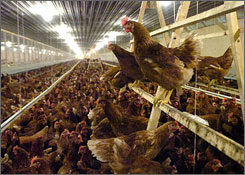In addition to changing Prime Ministers every 12 months (bye-bye Tony dumb-dumb) it’s almost impossible to buy cage eggs, at least without enduring the stigmatizing stares of other shoppers.
 But are consumers getting what’s advertised?
But are consumers getting what’s advertised?
Darling Downs Fresh Eggs must pay a $250,000 fine after the Federal Court ruled it had purposely mis-labelled its eggs as free range, in a case brought by the competition watchdog.
The court found that RL Adams Pty, the company behind the egg producer, engaged in misleading conduct and made misleading representations to consumers in labelling and promoting its eggs as `free range’ from December 2013 to October 2014.
The company admitted, in the course of the Australian Competition and Consumer Commission investigation, that it had kept its hens confined to barns at all times, and kept doors shut so the chickens never had access to an outdoor range.
“It’s clearly misleading to claim your eggs are free range when the hens that laid the eggs didn’t roam freely outdoors,” said ACCC chairman Rod Sims.
“People are willing to pay a premium for free range eggs which they believe meet ethical or welfare standards. Businesses should not be benefiting financially from misleading claims about farming practices,” he said.
The severity of the penalty was mitigated in part by Rl Adams’ co-operation with the ACCC investigation, said the court.


 Keehn’s blog post concluded by saying,
Keehn’s blog post concluded by saying, Buried in a
Buried in a